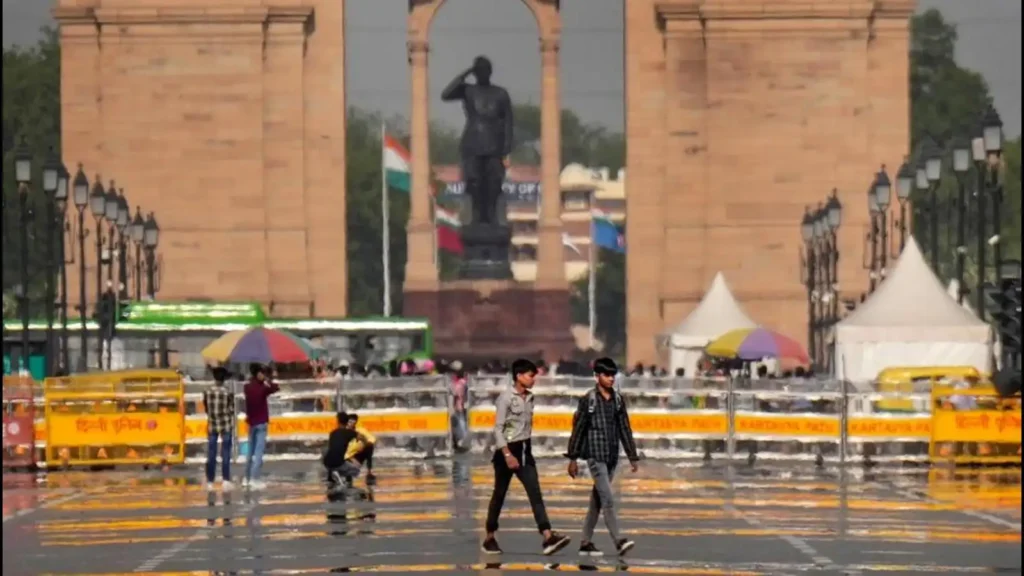Delhi Swelters as Night Temperature Hits 30.2°C — Hottest of the Season So Far
New Delhi, May 21, 2025 — The national capital woke up to an unusually warm morning on Wednesday as the mercury hit a scorching 30.2 degrees Celsius overnight — the highest minimum temperature recorded in Delhi so far this summer. This figure stands 3.5 degrees above the seasonal average and signals the intensifying grip of heatwave conditions in the region.

For a city that’s no stranger to extreme summers, this spike in minimum temperature is a concerning development. Typically, the nights offer some relief from the relentless daytime heat. However, this time, even the early morning hours offered little respite, making it difficult for residents to catch a break from the sweltering weather.
No Relief, Even After Sunset
The minimum temperature, which refers to the lowest temperature recorded in a 24-hour period — usually during the early morning — is a crucial metric in assessing heat stress on the human body. When the night-time temperature remains unusually high, it prevents the body from cooling down, leading to increased fatigue, discomfort, and even health complications for vulnerable groups such as older people, children, and those with pre-existing health conditions.
With the minimum temperature now hovering around 30°C, Delhiites are facing not just hot days but hot nights too, raising concerns about heat-related illnesses and a strain on basic infrastructure like power and water supply.
Prolonged Heat Stress Could Have Wider Impact
Meteorologists and health experts alike are warning that a sustained spell of elevated minimum temperatures could pose significant health risks. High night-time temperatures, in particular, can interfere with sleep, exacerbate chronic health issues, and put additional stress on people working outdoors, such as construction workers, delivery agents, and street vendors.
In recent years, the rise in minimum temperatures during summers has become a pattern across many parts of northern India. This could be attributed to a combination of factors such as urban heat island effects — where cities remain hotter due to dense infrastructure and reduced greenery — and the broader consequences of global warming.
Delhi’s Climate Getting Warmer, Say Experts
According to the India Meteorological Department (IMD), the rise in minimum temperature is part of a long-term warming trend affecting the Indian subcontinent. “The minimum temperature of 30.2°C is significantly above normal for this time of year. This is a clear indication of the growing intensity of summer heat in Delhi,” an IMD official noted.
This warming trend has been particularly evident over the last two decades. Data shows that both day and night temperatures are gradually inching upwards year after year. While occasional heat spikes are common during peak summer months, persistently high night temperatures are a more recent phenomenon — and they are harder to manage, both physically and in terms of infrastructure.
Power Demand Surges as Residents Turn to Air Conditioners
The heat is also pushing Delhi’s power demand to record highs. As people increasingly depend on air conditioners, coolers, and fans to beat the heat, the city’s electricity usage is surging. On Tuesday, Delhi’s peak power demand touched nearly 8,000 megawatts, one of the highest so far this season. Officials expect this figure to rise further in the coming days if temperatures continue to soar.
While the power infrastructure has improved over the years, any unexpected surge could strain the system, especially during extended heatwaves.
Water Supply Another Area of Concern
Another major concern during intense heat spells is the availability of drinking water. With higher temperatures, the demand for water rises sharply — not just for consumption but also for bathing, cleaning, and agriculture in surrounding areas. Already, some parts of Delhi are reporting reduced water pressure and irregular supply, especially in outer and less-developed areas.
The Delhi Jal Board (DJB) has issued advisories urging people to use water judiciously and has increased tanker deployments to meet the rising demand.
What the Forecast Says
According to the latest forecast by the IMD, there’s little immediate relief in sight. The weather is expected to remain dry and hot over the next few days, with daytime temperatures possibly touching 45°C in some parts of Delhi and neighboring regions like Gurugram, Noida, and Ghaziabad.
“There’s no indication of any significant weather system that could bring down the temperature in the coming days,” said an IMD official. “We advise people to stay indoors during peak afternoon hours, stay hydrated, and avoid strenuous physical activity during the day.”
How to Stay Safe During Extreme Heat
Authorities are urging citizens to take precautions to minimize the health risks posed by the heat. Here are a few simple yet essential tips:
- Stay Hydrated: Drink plenty of water, even if you don’t feel thirsty. Avoid sugary, caffeinated, or alcoholic beverages.
- Stay Indoors During Peak Hours: Avoid going out between 12 p.m. and 4 p.m., when the sun is at its harshest.
- Wear Light Clothing: Choose light-colored, loose-fitting cotton clothes that allow your body to breathe.
- Use Fans and Coolers Wisely: Ensure good ventilation in indoor spaces. Keep windows open during the cooler parts of the day and closed when it’s hottest.
- Help Others: Check in on older neighbors, people with disabilities, and those without access to cooling systems.
A Wake-Up Call for Climate Action?
While high temperatures are a routine part of Delhi’s summer, the rise in minimum temperatures adds a new dimension to the challenges posed by climate change. Experts say this is yet another sign that climate-resilient infrastructure, sustainable urban planning, and stronger public health systems are urgently needed.
As Delhi braces for more heat in the coming weeks, this latest temperature spike serves as a stark reminder that climate change is not a distant threat — it’s unfolding right now, and cities like Delhi are on the frontlines.






